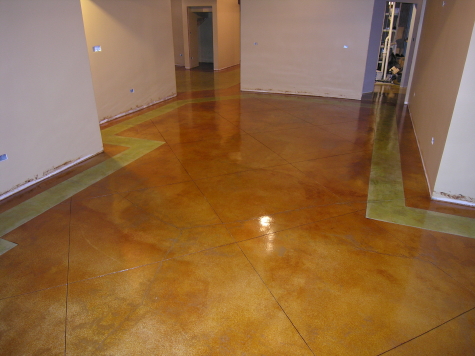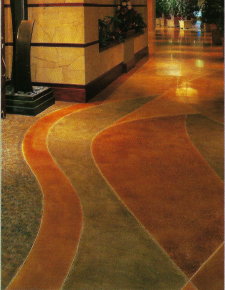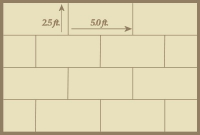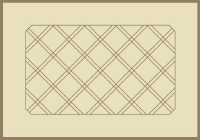DECORATIVE scoring
This acid-stained finished basement concrete floor had 3.5' diagonal Spanish tiles cut in the interior and an 18" border along the walls done in a contrasting color. Notice the distinct color separation on both sides of the border.
For a large open floor that is not obscured by a lot of furniture, or area rugs, saw-cutting, or "scoring", decorative lines and simple geometric patterns into acid-stained concrete is a great way to break up the monotony of a single color, and draw more attention to the floor. Decorative saw-cuts are generally made with a guided angle grinder, or concrete saw fitted with a diamond blade, and a dust-free vacuum attachment. The most common saw-cuts are about 1/8" wide, and 1/4" deep, but any exact dimensions can easily be set by a good acid-stained concrete contractor, if the customers so desires. These decorative saw-cuts are usually made prior to acid-staining the concrete, and may be filled with a colored grout, polyurea joint filler, or elastomeric urethane joint sealant, to accent the colors in the floor, or they may be left unfilled, for a more subtle appeal.
Decorative scoring was done to this hallway section of an acid-stained concrete floor, in a mall, with color separation, to create a "leading effect" for shoppers.
Straight wall borders, and large square or rectangular tiles, are the most popular decorative saw-cut patterns, while arcs, curves, circles, and diamonds are selected for a more contemporary, or artistic, look. For additional accenting, decorative concrete scoring cuts may be used to separate acid stain colors. Separating colors usually involves a few extra days' labor for a concrete staining contractor, though, so the customer should expect to pay a little more per square foot. Decorative concrete scoring patterns usually add about $.75-$1.50 per square foot to the cost of a project, depending on the complexity. Also, this type of decorative saw-cutting is generally not a problem with concrete slabs that contain radiant, or "hydronic", heating, as long as the tubing was properly installed by a professional, and is at least 1-2" below the surface of the concrete.
An example of a control joint in a basement concrete floor that looks out of place once the walls went up. We made additional saw-cuts before staining this floor in order to make a symmetrical-looking design.
Decorative saw-cuts are also a great way to incorporate unsightly, existing control joints into a larger overall pattern on a stained concrete floor, and thereby camouflage them. Often, excessive numbers of joints are placed in concrete, outdoors, as a way of minimizing or eliminating cracking. Indoors, a different problem occurs: isolated, single joints appear randomly in important living spaces, or throughout a series of rooms, detracting from the overall symmetry and ambience of these areas. These joints are seemingly misplaced, because the concrete floor in a house or building is generally placed before the walls go up. By strategically placing additional, decorative saw-cuts in a floor, however, these "misplaced" joints can become part of a larger pattern that gives overall symmetry and consistency to the space.
popular Acid-stained concrete scoring PATTERNS
The most popular acid-stained concrete scoring patterns are linear in nature. Below are some of the most common patterns.
Spanish Tile
Diagonal Spanish Tile
Offset Rectangular Tile
Rectangular Grid
Square Grid
Tall Slate
Bordered Diagonal Tile
Bordered Basketweave Slate
Contemporary Scored
Bordered Square Tile
Framed Diagonal Grid














